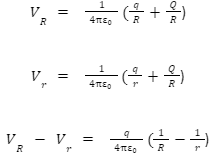The generator is named after Robert J. Van de Graaff. He was an American physicist. When two materials are rubbed together, depending on their triboelectric properties, an electron flow can occur. Static electricity is the result of a substance losing its electrons and becoming positively charged and a material gaining electrons and becoming negatively charged.
Van de Graaff is based on the principle of static electricity – that if a charged conductor is brought internally in contact with the hollow conductor all the charges from the inner conductor are transferred to the surface of the outer conductor no matter what amount of charge is already present on the outer shell.
The Principle Of Static Electricity
Let’s take a look at the construction and operation of the Van de Graaff generator.
Construction of the Van de Graaff generator
As depicted in the Van de Graaff generator diagram – Aluminium roller (B) and Plastic roller (C), a simple Van de Graaff generator consists of a rubber belt travelling over a pair of rollers. A hollow metallic sphere set on an insulated stand surrounds one of them. The electron emitter is positioned near the lower plastic roller in the form of a comb (D) made up of sharp metal points, with the comb pointing towards the rubber belt. External power keeps the comb at a high positive voltage. Another comb, the receiver comb (E), is located near the upper roller and is attached to a hollow metal sphere, which is moved by a motor connected to the bottom roller.
Van de Graaff generator diagram

Working of Van de Graaff generator
After the motor is switched on and is connected to the roller (C), the belt moves around the pulley. As per the principle of static electricity, Positive charges are sprayed on the outer edge of the belt by a spray comb located near the bottom roller and coupled to a high positive potential. Charges on the belt are carried upwards and are collected by the receiver comb on the top of the generator. The charge is transported to a hollow sphere because the upper comb is connected to a hollow conductor. The spherical shell accumulates a tremendous number of charges and creates enormous potential as the belt continuously transmits positive charges to the receiver comb. Due to the force of repulsion between the light charges on the dome, it becomes increasingly difficult for the surface to contain more and more charges. When the spherical shell’s potential exceeds the air’s breakdown value, the air around the sphere becomes ionised, causing charge leakage from the sphere. The Van de Graaff generator generates a beam of high-energy particles in the megavolt range.
Consider a huge spherical shell with a radius of R. If we apply a charge of magnitude Q to such a sphere, the charge will distribute evenly across its surface. So, the potential outside is that of a point charge; and inside it is constant, as we know the laws and principle of static electricity. We have: the potential inside the conducting spherical shell of the radius R of charge Q = constant and is as follows

Place a little sphere in the middle of the larger one, with the smaller sphere’s radius being r and the charge on its surface being q. On the little sphere’s surface:

The total potential energy due to the charges system is: The total potential energy owing to the system of charges is: If we analyse the total charges in the process, q and Q, then the total potential energy due to the system of charges is:

The ideal shape for the generator terminal is a sphere that has an inward curve near the hole at the place the belt enters. Greater potentials can be produced without ionisation of the surrounding air or dielectric gas because the electric field surrounding a rounded terminal is reduced. The electric field outside the sphere becomes exceedingly strong and outside charging is soon inhibited. Because there is no electric field inside electrically charged conductors, charges can be added continually from the inside without reaching the full potential of the external shell.
Because it can deliver the same little current at almost any level of electrical potential, a Van de Graaff generator is an example of a nearly perfect current source.
Uses of Van de Graaff generator
- It’s used to generate a high voltage range of a few million volts.
- It is used to accelerate projectiles such as protons, deuterons and other high-kinetic-energy particles that cause artificial transmutation when they hit their target.
- It’s used in Physics to investigate collision experiments.
- These beams are employed in cancer treatment.
Conclusion
The Van de Graaff generator works on the principle Of Static Electricity. When we ground the output terminal (spherical) with a grounded object on the Van de Graaff Generator, the voltage drops but the current stays the same. Static charges are formed by friction between two insulating bodies rubbing against each other and because they can’t move on their own (at rest), they’re called static charges. The construction and operation of the Van de Graaff generator are based on the physics of static electricity.
 Profile
Profile Settings
Settings Refer your friends
Refer your friends Sign out
Sign out






